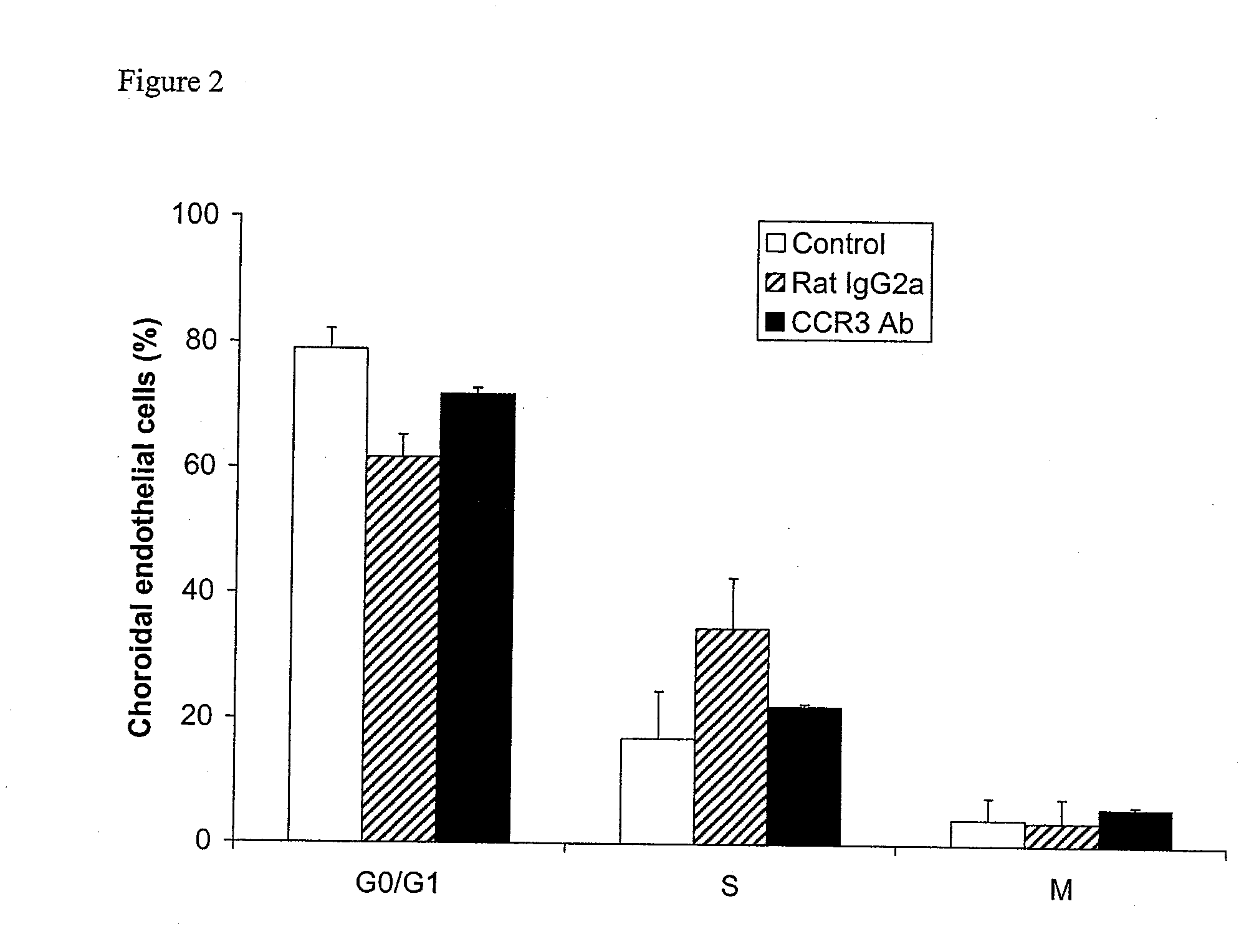CCR3 Inhibition for Ocular Angiogenesis and Macular Degeneration
a technology of ocular angiogenesis and ccr3, which is applied in the direction of metabolism disorders, drug compositions, peptides, etc., can solve the problems of severe vision loss in people, loss of central vision, and macular degeneration, and achieve the effect of inhibiting ocular angiogenesis and inhibiting the activity of ccr3
- Summary
- Abstract
- Description
- Claims
- Application Information
AI Technical Summary
Benefits of technology
Problems solved by technology
Method used
Image
Examples
example 1
Methods
[0053]Laser photocoagulation (532 nm, 200 mW, 100 ms, 75 μm) (OcuLight GL, Iridex Corporation) was performed (volume studies: 3 / eye; protein analyses / flow cytometry: 12 / eye) on both eyes of each animal to induce CNV (choroidal neovascularization). CNV volumes were measured by scanning laser confocal microscope (TCS SP, Leica) with 0.5% FITC-Griffonia simplicifolia Isolectin B4 (Vector Laboratories). CNV was induced by laser injury in C57BL / 6J and Ccr3− / − mice and volumes measured 7 days later by confocal evaluation of Griffonia simplicifolia Isolectin B4 staining of RPE-choroid flatmounts. Neutralizing antibodies (Ab) against CCR3, eotaxin (CCL-11), eotaxin-2 (CCL-24), RANTES, MCP-3 or control goat IgG or rat IgG2a were injected into the vitreous humor following injury.
[0054]Flow cytometry was used to determine the numbers of eosinophils, mast cells and macrophages in the choroid, expression of CCR3 by various cell types in the eye, and the cell cycle state of choroidal endot...
example 2
Methods
[0058]Male C57BL / 6J mice (Jackson Laboratories) between 6 and 8 weeks of age were used to minimize variability. For all procedures, anesthesia was achieved by intraperitoneal injection of 50 mg / kg ketamine hydrochloride (Ft. Dodge Animal Health) and 10 mg / kg xylazine (Phoenix Scientific), and pupils were dilated with topical 1% tropicamide (Alcon Laboratories).
[0059]Laser photocoagulation (532 nm, 200 mW, 100 ms, 75 μm) (OcuLight GL, Iridex Corporation) was performed (volume studies: 3 / eye; protein analyses / flow cytometry: 12 / eye) on both eyes of each animal to induce CNV. CNV volumes were measured by scanning laser confocal microscope (TCS SP, Leica) with 0.5% FITC-Griffonia simplicifolia Isolectin B4 (Vector Laboratories) or 0.5% FITC-rat antibody against mouse CD31 (BD Biosciences). Volumes obtained by lectin and CD31 staining were highly correlated (r2=0.95). (S)-Methyl-2-naphthoylamino-3-(4-nitrophenyl)propionate (SB328437; Calbiochem) dissolved in DMSO was injected into...
example 3
[0062]A F-actin polymerization assay was performed. 10,000 cells from early passage primary hCEC isolates (n=3) were seeded in black-walled 96-well plates and grown to 70-80% confluency in fully supplemented EGM-2MV. Cultures were serum starved overnight in basal media and then stimulated with recombinant human eotaxin-1 (10 ng / mL), eotaxin-2 (100 ng / mL), eotaxin-3 (2 μg / mL) (Peprotech), or vehicle control (PBS). At 0, 10, 30, 60, or 120 second time-points (n=4 per group), cells were fixed in 3.7% paraformaldehyde for 10 minutes, washed, permeabilized in PBS with 0.1% Triton-X, and then stained with rhodamine labeled Phalloidin (1:200, Invitrogen) per manufacturer's recommendations. Plates were analyzed on a fluorescent plate reader (Synergy 4, Biotek) followed by fluorescent microscopy (Nikon E800).
[0063]F-actin polymer ratios between baseline and treated cultures were calculated using a fluorescent based plate assay. As seen in FIG. 9, polymerization peaked at 10 seconds after sti...
PUM
| Property | Measurement | Unit |
|---|---|---|
| Molecular weight | aaaaa | aaaaa |
Abstract
Description
Claims
Application Information
 Login to View More
Login to View More - R&D
- Intellectual Property
- Life Sciences
- Materials
- Tech Scout
- Unparalleled Data Quality
- Higher Quality Content
- 60% Fewer Hallucinations
Browse by: Latest US Patents, China's latest patents, Technical Efficacy Thesaurus, Application Domain, Technology Topic, Popular Technical Reports.
© 2025 PatSnap. All rights reserved.Legal|Privacy policy|Modern Slavery Act Transparency Statement|Sitemap|About US| Contact US: help@patsnap.com



